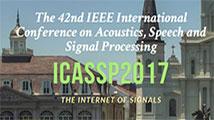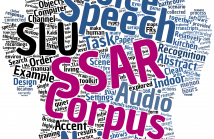
ICASSP is the world's largest and most comprehensive technical conference on signal processing and its applications. It provides a fantastic networking opportunity for like-minded professionals from around the world. ICASSP 2017 conference will feature world-class presentations by internationally renowned speakers and cutting-edge session topics. Visit ICASSP 2017

- Read more about THE SHEFFIELD SEARCH AND RESCUE CORPUS
- Log in to post comments
As part of an ongoing research into extracting mission-critical information from Search and Rescue speech communications, a corpus of unscripted, goal-oriented, two-party spoken conversations has been designed and collected. The Sheffield Search and Rescue (SSAR) corpus comprises about 12 hours of data from 96 conversations by 24 native speakers of British English with a southern accent. Each conversation is about a collaborative task of exploring and estimating a simulated indoor environment.
- Categories:
 5 Views
5 Views- Read more about NOVEL AMPLITUDE SCALING METHOD FOR BILINEAR FREQUENCY WARPING-BASED VOICE CONVERSION
- Log in to post comments
In frequency warping (FW)-based Voice Conversion (VC), the source spectrum is modified to match the frequency-axis of the target spectrum followed by an Amplitude Scaling (AS) to compensate the amplitude differences between the warped spectrum and the actual target spectrum. In this paper, we propose a novel AS technique which linearly transfers the amplitude of the frequency warped spectrum using the knowledge of a Gaussian Mixture Model (GMM)-based converted spectrum without adding any spurious peaks.
- Categories:
 18 Views
18 Views- Read more about Dual-Tree Wavelet Scattering Network with Parametric Log Transformation for Object Classification
- Log in to post comments
- Categories:
 12 Views
12 Views- Read more about Online Empirical Mode Decomposition
- Log in to post comments
The success of Empirical Mode Decomposition (EMD) resides in its practical approach to dissect non-stationary data. EMD repetitively goes through the entire data span to iteratively extract Intrinsic Mode Functions (IMFs). This approach, however, is not suitable for data stream as the entire data set has to be reconsidered every time a new point is added. To overcome this, we propose Online EMD, an algorithm that extracts IMFs on the fly.
- Categories:
 85 Views
85 Views- Read more about SPEAKER SEGMENTATION USING DEEP SPEAKER VECTORS FOR FAST SPEAKER CHANGE SCENARIOS
- Log in to post comments
A novel speaker segmentation approach based on deep neural network is proposed and investigated. This approach uses deep speaker vectors (d-vectors) to represent speaker characteristics and to find speaker change points. The d-vector is a kind of frame-level speaker recognition feature, whose discriminative training process corresponds to the goal of discriminating a speaker change point from a single speaker speech segment in a short time window.
- Categories:
 12 Views
12 Views- Read more about Double Relay Communication Protocol with Power Control for Achieving Fairness in Cellular Systems
- Log in to post comments
The growing demand for wireless connectivity has turned bandwidth into a scarce resource that has to be carefully managed and fairly distributed to users. However, the variability of the wireless channel can severely degrade the service received by each user. The Double Relay Communication Protocol (DRCP) is a transmission scheme that addresses these problems by exploiting spatial diversity to enhance the fairness of the system without requiring any additional infrastructure (i.e relay nodes or a backhaul connection).
- Categories:
 21 Views
21 Views- Read more about Wirtinger Flow Method with Optimal Stepsize for Phase Retrieval
- Log in to post comments
The recently reported Wirtinger flow (WF) algorithm has been demonstrated as a promising method for solving the problem of phase retrieval by applying a gradient descent scheme. An empirical choice of stepsize is suggested in practice. However, this heuristic stepsize selection rule is not optimal. In order to accelerate the convergence rate, we propose an improved WF with optimal stepsize. It is revealed that this optimal stepsize is the solution of a univariate cubic equation with real-valued coefficients.
- Categories:
 33 Views
33 Views- Read more about Application of Compressed Sensing to Wideband Spectrum Sensing in Cognitive Radio Networks
- Log in to post comments
- Categories:
 7 Views
7 Views- Read more about PHASE ESTIMATION IN SINGLE-CHANNEL SPEECH ENHANCEMENT USING PHASE INVARIANCE CONSTRAINTS
- Log in to post comments
ICASSP2017.pdf
- Categories:
 11 Views
11 Views- Read more about COMPRESSIVE PULSE-DOPPLER RADAR SENSING VIA ONE-BIT SAMPLING WITH TIME-VARYING THRESHOLD
- Log in to post comments
- Categories:
 27 Views
27 Views